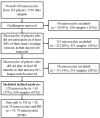Female Soccer Players' In-Season Weekly Training Load and Intensity: Comparison between National League's Top and Bottom-Half Ranked Teams
- PMID: 39944977
- PMCID: PMC11812167
- DOI: 10.5114/jhk/189657
Female Soccer Players' In-Season Weekly Training Load and Intensity: Comparison between National League's Top and Bottom-Half Ranked Teams
Abstract
This study aimed to (1) quantify national-level female soccer players' accumulated microcycle (weekly) training load (accumulated absolute value) and intensity (value relative to duration), (2) investigate possible differences in training load and intensity between teams in the league's top- and bottom-half. Sixty-three females from six teams in the highest league participated in the study. Participants were divided into top-half (TH, n = 28) and bottom-half (BH, n = 35) groups based on their team's league ranking. Players' external and internal training load and intensity were monitored in all on-field training sessions and league matches during a three-week observation period (690 data samples) using the Polar Team Pro system. There were no differences between groups in the number of weekly training sessions or total duration. Accumulated external and internal load were highly similar between groups. Instead, the TH group reached significantly higher values than the BH group in multiple external intensity variables, such as total distance per minute and the number of low-, moderate- and high-intensity accelerations per minute (p = 0.004-0.001). There were no differences in the mean heart rate between groups. The TH group's training external intensity was also closer to match intensity in multiple variables, such as total distance and the number of low- and moderate-intensity accelerations and decelerations compared to the BH group (p = 0.029-0.001). These findings suggest that more successful teams achieved higher external intensity for the same internal response, and their average external training intensity was closer to match demands. Thus, it seems plausible that TH players had better physical qualities and their training prepared them better for matches than BH.
Keywords: external load; internal load; microcycle; soccer; women.
Copyright: © Academy of Physical Education in Katowice.
Conflict of interest statement
The authors declare no conflict of interest.
Figures


Similar articles
-
Changes in female football players' in-season training load, intensity and physical performance: training progression matters more than accumulated load.Front Sports Act Living. 2024 Oct 24;6:1454519. doi: 10.3389/fspor.2024.1454519. eCollection 2024. Front Sports Act Living. 2024. PMID: 39512665 Free PMC article.
-
Daily and weekly external loads in the microcycle: Characterization and comparison between playing positions on amateur soccer.Front Sports Act Living. 2022 Sep 15;4:943367. doi: 10.3389/fspor.2022.943367. eCollection 2022. Front Sports Act Living. 2022. PMID: 36187710 Free PMC article.
-
The Ratio between Weekly Training and Match External Physical Loads in U17 Elite Youth Soccer Players: Implications for the Training Process.J Sports Sci Med. 2024 Mar 1;23(1):107-113. doi: 10.52082/jssm.2024.107. eCollection 2024 Mar. J Sports Sci Med. 2024. PMID: 38455444 Free PMC article.
-
Analysis of Intensities Using Inertial Motion Devices in Female Soccer: Do You Train like You Compete?Sensors (Basel). 2022 Apr 8;22(8):2870. doi: 10.3390/s22082870. Sensors (Basel). 2022. PMID: 35458863 Free PMC article.
-
High-Intensity Acceleration and Deceleration Demands in Elite Team Sports Competitive Match Play: A Systematic Review and Meta-Analysis of Observational Studies.Sports Med. 2019 Dec;49(12):1923-1947. doi: 10.1007/s40279-019-01170-1. Sports Med. 2019. PMID: 31506901 Free PMC article.
Cited by
-
Impact of Chronic Nitrate and Citrulline Malate Supplementation on Performance and Recovery in Spanish Professional Female Soccer Players: A Randomized Controlled Trial.Nutrients. 2025 Jul 21;17(14):2381. doi: 10.3390/nu17142381. Nutrients. 2025. PMID: 40733006 Free PMC article. Clinical Trial.
References
-
- Chamera, T, Pronczuk, M, Smok, P, Drozd, M, Michalczyk, M, & Maszczyk, A. The effects of resistance training on jumping and selected power variables of the lower limbs in female soccer players. Balt J Health Phys Act. 2023;15(3): Article7. 10.29359/BJHPA.15.3.07 - DOI
-
- Coppalle, S., Ravé, G., Moran, J., Salhi, I., Abderrahman, A. Ben, Zouita, S., Granacher, U., & Zouhal, H. (2021). Internal and external training load in under-19 versus professional soccer players during the in-season period. International Journal of Environmental Research and Public Health, 18(2), 1–10. 10.3390/ijerph18020558 - DOI - PMC - PubMed
-
- Diaz-Seradilla, E., Rodríguez-Fernández, A., Rodríguez-Marroyo, J. A., Castillo, D., Raya-González, J., & Vicente, J. G. V. (2022). Inter- and intra-microcycle external load analysis in female professional soccer players: A playing position approach. PLoS ONE, 17(3), e0264908. 10.1371/journal.pone.0264908 - DOI - PMC - PubMed
LinkOut - more resources
Full Text Sources
